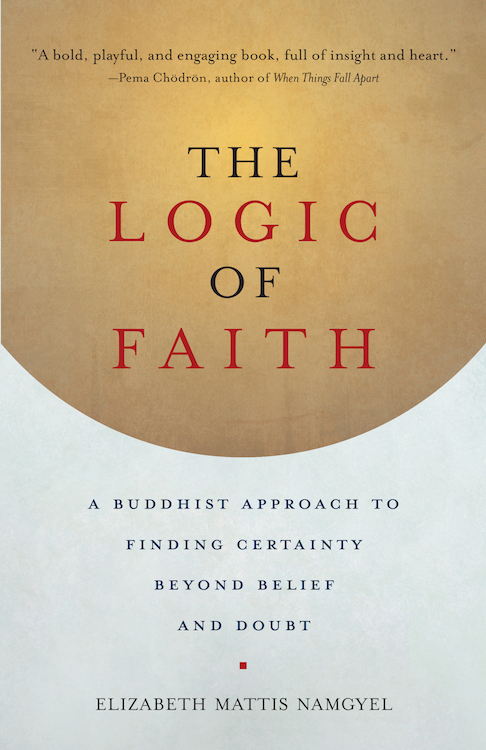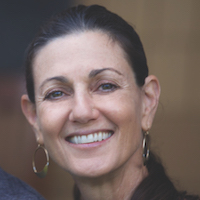
From The Logic of Faith by Elizabeth Mattis Namgyel © 2018 by Elizabeth Mattis-Namgyel. Reprinted in arrangement with Shambhala Publications, Inc. Boulder, CO. www.shambhala.com
~
“I am not contained between my hat and boots.” ~ Walt Whitman
~
In this section, let’s see whether we can find anything that doesn’t lean. We will be looking for something that stands alone, something that isn’t influenced by other elements or dependent upon causes and conditions. Do you think you can find such a thing?
In the 1960s and 70s the cosmologist and astronomer Carl Sagan challenged the notion of autonomy with a statement: “If you wish to make an apple pie from scratch, you must first invent the universe.”
In the good old days everyone had time to make pies from scratch. No one had invented piecrust mixes (yet). Then in the 1930s and 40s some industrious person started marketing boxes of premixed piecrust ingredients, and in the 1950s cultural icon Betty Crocker made the product even more prevalent. Her packaged ingredients only required the addition of water and oil—sometimes eggs. Thanks to Betty, we now have a choice: we can save the time it takes to measure ingredients and crack eggs, or we can go at it the old-fashioned way and start from scratch.
But even if you do go the old-fashioned route, does that extra bit of work it takes to mix individual ingredients together constitute baking a pie from scratch? In your attempt to make a pie from scratch, where would you begin? You might learn to farm. You then would have to buy some land, set up an irrigation system, acquire some heavy machinery (or at least a draft horse and plow), and collect some seeds.
You may feel satisfied that if you were to plant seeds, harvest, thresh, and grind the wheat into the flour with which to make your piecrust, you would have made an apple pie from scratch. But in fact, each individual seed has an origin—each one came from generations of wheat plants. You can never know the story of each individual seed; you can only infer that at some point in time someone discovered a wheat plant and recognized its potential.
According to historians, wheat originated in the Levant region of the Near East, along the Fertile Crescent. They have recently narrowed the location down to Turkey, where wheat dates as far back as 7,500 B.C.E. As far as we know, the survival of wheat has always relied upon sunshine, water, carbon dioxide, and nutrient-rich soil. Wheat required farmers, landowners, and workers to process it into flour. I’m sure there were all kinds of politics around the economics and distribution of wheat, as there are now.
You could focus your attention on nothing but the origin of wheat for eternity and never exhaust the topic. That’s because in looking at the interconnectedness of anything, you will find endless stories, information, challenges, and adventures, which will again open into other stories, and so on. You will never reach definitive conclusions about this thing you call wheat. Like all things, its nature is boundless and free of the constraints of your designating labels.
And we haven’t even gotten to the apples yet.
Carl Sagan’s quote once inspired me to make an apple pie. It was August, my tree was heavy with apples, my dad’s birthday was around the corner, and he loves apple pie. Lucky for me, my dear friend Peggy Markel, who takes people on exotic cooking tours in places like Morocco, Italy, and India, paid me a visit. The evening before her arrival I had planned on harvesting the apples from my tree. But that night a bear ravaged them all with the exception of one little apple, which fearfully clung to the top of the only branch the bear hadn’t torn away from the tree’s trunk. There is a lot contingent upon making an apple pie, and sometimes the universe seems to conspire against you! Instead of reading too much into it though, I just went to town and bought a bag of local apples.
Making a good apple pie requires a lot of experimentation. Peggy and I played with kneading the dough by hand versus putting it all in a food processor. We tried adding more or less water to get the best consistency. We had to adjust the oven temperature for high altitude. And there are numerous styles of apple pies to choose from—rustic, traditional, the kind with a lattice upper crust, apple crumble, and tarte tatin, just to name a few. Each has its own history and place of origin, and we tried many variations, employing most of my kitchen tools, pie pans, and ingredients. Peggy, it turns out, is tireless when it comes to the science of pie making, and we worked through every possibility.
At the end of the day, I felt proud, in particular, of our most traditional creation, which we decorated with leaves shaped of dough. I felt as if we had really accomplished something—but only for a moment. Sagan’s words came back to me to put a halt to my bravado, reminding me that I couldn’t possibly be the sole cause of this pie. This pie was not the product of one person’s pie-making inspiration—one recipe, one list of ingredients, or one baker to execute it. The creation of this pie was not the result of a singular cause. It wasn’t a linear process at all. In fact, it took full-on universal participation. I think this is Sagan’s point: an apple pie is not a closed system but relies upon the cooperation of the entire universe.
At first glance, Carl Sagan’s statement seems to challenge us to find where an apple pie ends and the world begins. But I suspect his intention was to get us to think about something that goes way beyond dessert. I think his words were meant to provoke us into exploring who we are in relationship to the universe. His statement shows us that who we are—the experiencer—and the world we perceive are not the same or separate, not one or two, but rather share a relationship of interdependence. You can apply the same analysis to your self. Where do you end and does your world begin?
Think about the origin of you. You may think of the story as a linear history. Your parents met, say, at their university. Think of all the causes and conditions that had to come together for that to happen! They could have gone to different schools. Or even if they attended the same school, what if their friends hadn’t introduced them? Or having met, what if one of them wasn’t impressed? Or what if one of them had a fatal accident just after they were married? And what if things hadn’t panned out biologically?
When you begin to look at conception, gestation, and the survival of a fetus in the womb, you enter into an entire universe of contingency. You will encounter the life of zygotes, dividing cells, and hormones. You will come to see that your existence hinged on a single and tenacious sperm’s “decision” to turn right instead of left at the intersection of your mom’s fallopian turnpikes. Then, if “he” made it to the egg, “she” had to deem him worthy of acceptance. After conception takes place the life of the fetus then relies on a billion other things to go right—but wow, here you are. What a miracle.
What are the causes and conditions that brought you to where you are, in this very moment? Use the prowess of your imagination—explore. Don’t dismiss your imagination as invalid or untrue. Remember: All thoughts and memories are imaginary. Yet the way you understand your world has a potent effect on the direction your life takes and how you navigate it. Let yourself explore this fathomless self that has no boundary, no beginning or end—that keeps opening and opening into galaxies of experience.
When I think about the nature of pratityasamutpada, I am overcome with gratitude and awe. I might say that this aspect of my mind is what I cherish most—but it’s not really an aspect of mind. It is what I experience when I am not confused about who I am in the larger scheme of things. When I feel connected to the infinite nature of interdependent expression, I call that grace.
Maybe you are beginning to catch on to how the practices of pratityasamutpada help you see beyond a mistaken notion of a singular, permanent, or autonomous me. This seeing through the self is something many people have contemplated. In fact, Einstein once said that what humans single out as a separate self is a kind of optical delusion of our consciousness.
The meteorologist Edward Lorenz, when exploring the interconnectedness of weather patterns, asked his famous question: “Does a butterfly fluttering its wings in Brazil set off a tornado in Texas?” Because everything leans, something as delicate as the wings of a butterfly has reverberating effects on everything that happens everywhere in the entire cosmos and beyond. So imagine what that means for you too.
The investigations of the Middle Way tradition make it clear that autonomy will never be an option. So don’t waste your time trying to single yourself out of the bigger picture. You are not big, nor are you small. You are not important, nor are you insignificant. And you cannot be affirmed or denied. You are not the same as everything else, but neither are you separate. You are beyond the limitations of ordinary thinking, and you cannot be captured in thought.
So just in case you are still wondering, “But who am I then?” on behalf of the late Mr. Sagan I will respond in a way I think he would have agreed: “You are a part of the great nature of contingency, and everything you do matters.”
~
Relephant:
~~
~
~
~
Author: Elizabeth Mattis-Namgyel
Image: Science Freak/Pixabay; Shambhala Publications
Editor: Travis May
Copy & Social Editor: Nicole Cameron








Read 0 comments and reply